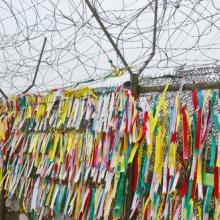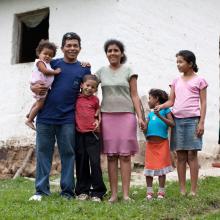Mexico

Image via REUTERS/Edgard Garrido/RNS
On a recent morning outside the Church of San Agustin in the middle-class neighborhood of Narvarte, two students sell bric-a-brac and blast the Beatles’ “Let It Be” through a smartphone hooked up to speakers. When asked what Pope Francis’ first visit to the country as pontiff on Feb. 12 means to them, they shrug. “It’s not like he’s going to come in and magically make all of our problems go away,” said Uriel Velazquez Tonantzin, 20, who dropped out of seminary a year ago to take a music composition program.

Photo via giulio napolitano / Shutterstock.com
Pope Francis’ visit to Mexico next month is supposed to be more of a pilgrimage than a spring break, but a viral video of the pontiff joking about tequila with a Mexican man in St. Peter’s Square captures the voluble enthusiasm that is likely to greet the first Latin American pontiff.
In the video, Francis can be seen walking around St. Peter’s Square, flanked by his security detail as he greets the faithful, when a man shouts from the crowd, catching the pontiff’s attention.
“Pope! We’ll be waiting for you in Mexico! Mexico, Pope!” the man yells above the din.
“Welcome to Mexico in February!”
“With tequila?” responds the leader of the world’s 1.2 billion Catholics.

People gather near a crime scene in Ciudad Juarez. Image via REUTERS / Jose Luis Gonzalez / RNS
Pope Francis will visit a prison and celebrate Mass in Ciudad Juarez, the Mexican border city plagued by violence in recent years, the Vatican has said in an announcement of details of the pontiff’s upcoming visit to Mexico.
The pope’s visit to Ciudad Juarez will conclude his six-day Mexico tour, starting on Feb. 12. The stop will draw attention to drug-related violence and the U.S. policy on migration.
While in the city on Feb. 17, Francis will tour a prison, meet with workers, and celebrate Mass at the fairgrounds close to the border. Around 220,000 people are expected to attend the Mass, with tickets offered to parishes on both sides of the Mexico-U.S. border.

Image via Chad Zuber / Shutterstock
The Vatican announced Oct. 6 that Pope Francis would visit Mexico in 2016, reports the Huffington Post.
It has also been confirmed that on the trip, he will go to the shrine of Our Lady of Guadalupe. In addition, he is expected to go to a location at the border with the U.S. where immigrants without papers try to make the perilous journey north.
Unlike Christianity, Judaism, and Islam, historically all led by men, or the philosophies of the East such as Buddhism where male scholars and monks dominate, folk religions — close to village or tribe or ancestry — are often practiced and led by women.
Santa Muerte expert Andrew Chesnut, professor of religious studies at Virginia Commonwealth University and author of a book on the Mexican folk religion, Devoted to Death, calls it “the fastest-growing New Religious Movement in the Americas,” with more than 10 million followers.
Pope Francis on Tuesday waded into the controversy of the wave of unaccompanied minors arriving at the U.S.-Mexico border, calling for an end to racism against migrants and pushing the U.S. to offer greater protection for young children entering the country illegally.
“Many of their rights are violated, they are obliged to separate from their families and, unfortunately, continue to be the subject of racist and xenophobic attitudes.”
The Argentine pontiff said a different approach is needed to tackling what he called a “humanitarian emergency” as growing numbers of unaccompanied children are migrating to the U.S. from Central America and Mexico.
Walls exist between U.S. and Mexico. A few years ago, I took a class to the Mexico-U.S. border through BorderLinks, an organization that provides educational experiences to connect divided communities, raise awareness about border and immigration policies and their impact, and inspires people to act for social transformation. We visited the metal wall that separates the United States from Mexico at Nogales, Mexico.
The walls went up in 1994.
The North American Free Trade Agreement (NAFTA), established in 1994, was supposed to help with trade and the economic status of Mexico. However, it failed to do this. It backfired and made the economic situation worse for the people of Mexico. Rich corporations and companies that benefited from the Free Trade Agreement as they were able to move their factories down to Mexico where the labor was cheap and profits higher. As the economy of Mexico suffered, more people made their way, without documents, to the United States to seek work so they could support their families.
In 2006, the United States responded with the Secure Fence Act. As President George W. Bush signed the bill, he stated, “This bill will help protect the American people. This bill will make our borders more secure. It is an important step toward immigration reform.” The act included provisions for the construction of physical barriers — walls — and the use of technology to these ends.
This wall is under constant surveillance to prevent people from entering into the U.S. illegally. Ironically, it is a wall built from the remaining metal landing scraps of the Gulf War. The border is highly militarized with patrols who treat migrants as “prisoners of war.” It symbolizes militarization, greed, xenophobia, hatred, pride, nonsense, and fear of the other, a reminder of wanting to protect what is yours and not sharing what God has given you. Walls continue to go up along the border as the people of the United States continue to fear that undocumented people will take away jobs. These fears may devastate the lives of the poor in both countries.
The Anna Louise Inn first opened in 1909. Built on the Taft family’s front yard, the Inn provided safe and affordable housing for women in Cincinnati. Since then, the Inn has become a revered Cincinnati institution. Click on the gallery below to view some images of the Inn’s history.
On my knees I beg forgiveness for my greed—
and for starving myself.
By your eyes I see you love this priest,
follow his lyrical fingers in praise of
a small white host he points here,
there.
MARTA AND LUISA had always fantasized about leaving their small town in northern Mexico to become dancers in a big city.
As the teenage sisters sat in the bed of a rusted pickup truck speeding toward the U.S. border, they thought their dreams would soon become reality. After sunset, the truck screeched to an abrupt stop. A middle-aged man with a skeleton tattoo on his arm hopped out of the driver’s seat, gritted his yellow teeth, and mumbled, “Vamos.” The time had come to complete the journey by foot.
Marta and Luisa walked closely behind the man and his two associates for hours along the desert paths they believed led to a brighter future. When they crossed the border into Arizona at about midnight, the tattooed man forcefully grabbed 16-year-old Marta and separated her from her older sister.
He explained that although he previously offered to help the girls cross the border for a small fee, the transportation cost had risen. Now Marta would have to work to pay off her debt. Alone.
Cecilia Hilton Gomez, director of Hispanic outreach programs for Free for Life International, describes the way that many human traffickers prey on vulnerable girls hoping to emigrate to the United States from Mexico and other parts of Central America. Since girls like Marta often have little education, lack formal paperwork, and have no knowledge of English, they become prime targets for traffickers looking to profit by selling women to brothel owners in the U.S.
“This is an epidemic, and it’s increasing,” Gomez states. “A lot of people think slavery has been gone for years, but it’s one of the largest criminal enterprises that exists now, and it’s right here in America.”
ON A BLAZING August day last summer, Rosa Pérez Triana faced a crowd of several hundred people in downtown Tucson and held up a color photo of a pretty young woman.
“This is my daughter, Coral,” Pérez said in Spanish, her voice breaking. “A year ago she went missing. There are thousands of people in Mexico like me who don’t know what happened to their loved ones.”
A middle-aged woman from the violent state of Nuevo León in northern Mexico, Pérez had come to the United States with the Caravan for Peace with Justice and Dignity to tell her North American neighbors what had happened to her daughter—and to an estimated 80,000 other Mexicans who have been killed or disappeared during the country’s six-year-old war on drugs.
Her daughter’s story is typical. Guadalupe Coral Pérez Triana vanished on July 24, 2011, somewhere on the road between Reynosa, Tamaulipas, and Monterrey, Nuevo León. Five other young women were traveling with her. All are missing and presumed dead.
“The main purpose of the caravan is to show a human face,” explained Laura Carlsen, director of the Center for International Policy’s Americas Program in Mexico, who joined the caravan on its last leg through the East Coast. “These are people whose family members were victims.” Such are the human costs of the war on drugs that the U.S. government supports with arms and money.
The Angels of Advent are saying, "Do not be afraid" -- we bring good news of immigration reform.
And what does fear do to us?
We disregard the good news at our doorstep, the opportunity to live with Jesus among us, and keep on building walls at our threshold. Perhaps that's why the angels of the Bible repeat this admonishment -- Do not be afraid -- over and over again, for fear inhibits our ability to see and hear a new vision.
I remember as a child wanting to leave the lights on in my room at night. The shadows and sounds were too much for an imagination that could run wild to handle. As adults, of course, it's our duty to assure children that nothing is living in their closets or under their beds. We offer the comfort of reality so that the child will go to sleep and have sweet dreams.
But you have to admit, as adults we are gripped by the same fear but on a different level. We may compulsively check to make sure the front door is locked. We don't look strangers in the eye (especially those we deem to look "strange") as we pass them on the street.
Bralyan loves bugs.
I met him during the first week of school as I conducted the standard assessment of how many words he could read per minute from a second-grade story. After the assessment, I gave him the customary caterpillar sticker to put on his shirt to show everyone that he was going to emerge as a great reader during his second-grade year.
You would have thought that I had given him a piece of gold.
"Oooh, I love bugs," he marveled as I handed him the sticker. "I have seen caterpillars around the trees at my apartment. They spin a chrysalis and turn into butterflies.
“Have you seen a roly poly bug?,” he continued. “They're my favorites!"
And so a friendship began around the pyrrharctia isabella, the armadillidum vulgar and other bugs that make up the most diverse group of animals on the planet.
This interaction told me some crucial things about Bralyan. It told me he is a smart kid, and it also told me that keeping him engaged in school would likely include bugs.
I later learned that Bralyan and his family moved here from Mexico when he was a baby. His mom and dad speak only Spanish at home. He speaks English at school.
According to a piece in USA Today, the congregants of one Mexican church don't think so:
A crusading Roman Catholic priest who has defied drug cartels and corrupt police to protect Central American migrants said Wednesday that church authorities are trying to smother his activist work with migrants by assigning him to parish duties.
The Rev. Alejandro Solalinde has become well known in Mexico after enduring death threats for publicly denouncing drug gangs and police who rob and kidnap Central American migrants crossing Mexico to reach the United States.
But Solalinde's diocese said he is simply being asked to start operating within the normal parish structure, and run his migrant shelter more like a church ministry and less like a lone activist's non-governmental organization.
Read more here
Fight global poverty, invest in agriculture. ~ Growers First
As the winter winds bite at our collars, a hot cup of coffee is a perfect antidote for healing. But what you might not consider when you sip a mug of dark roast is the economic injustices that many coffee growers around the world face.
Coffee is one of the largest cash crops in the world – the U.S.D.A. Foreign Agricultural Service reports that last year 15,689,340,000 pounds of coffee were distributed worldwide. Yet, indigenous coffee growers see only a tiny fraction of its revenue.
These are some of the reasons why fair exchange programs such as Growers First got into the coffee business — to tip the scales of economic and social inequity that has become a way of life for many coffee farmers globally in a more just direction.
Even more importantly, Growers First exists to transform lives. The non-profit based in Laguna Beach, Calif., has a powerful story of action, conflict, struggle — and ultimately hope.
In 1884, Romney’s great-grandfather, Miles Parker Romney, fled to Mexico from Utah. Miles Parker Romney was a practicing polygamist and he wanted to protect his family from persecution. Mitt Romney’s father was born in Mexico, his family returned to the United States and took up residence in Michigan.
While Romney wouldn’t agree with his ancestor’s practice of polygamy, I am sure he understands his great-grandfather’s desire to do what he thought best for his family. Luckily for Miles Parker Romney, there was a country that allowed his family to settle and try and find a better life.
What is unfortunate is that candidate Romney doesn't seem to have that same kind of empathy for families today who are also in difficult positions.
| The Daily Show With Jon Stewart | Mon - Thurs 11p / 10c | |||
| Mexed Out | ||||
| ||||
How ironic that for all the protests going on about unemployment these days that a parallel debate is occurring in our agricultural sector: What to do about a shortage of workers to pick crops or care for livestock on U.S. farms.
The Christianized Jesus -- the turning of a radical into a conservative shadow of his former self -- explains our problem of establishing and celebrating freedom fighters today. It is important that our progressive heroes be given their deserved fame, an accurately reported fame, and this is crucial in ways that impact our own activism.
Jesus of Nazareth was not a Peak Performance Strategist as the prosperity preachers would have it. Nor was he a foreigner-hating patriot as the tea party would argue. Obviously American politicians and their lobbyists pursue so many policies that are against the teachings of Jesus but are supported by mainstream Christian opinion. In fact, Jesus' parables and sayings push the spiritual revolution of gift economies, and of justice through radical forgiveness.





